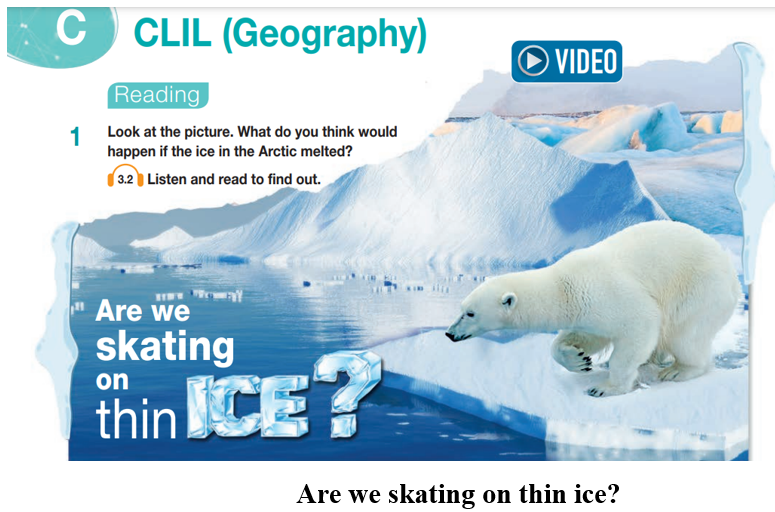Collect information about other effects that the melting of polar ice caps will have on the Earth. Present it to the class. (Thu thập thông tin về các tác động khác mà sự tan chảy của các chỏm băng ở hai cực sẽ gây ra đối với Trái đất. Trình bày trước lớp.)
Collect information about other effects that the melting of polar ice caps will have on the Earth. Present it to the class. (Thu thập thông tin về các tác động khác mà sự tan chảy của các chỏm băng ở hai cực sẽ gây ra đối với Trái đất. Trình bày trước lớp.)
Quảng cáo
Trả lời:
When the ice caps melt, the sea level isn’t directly affected because this ice is already in the ocean. But scientists say that floating ice shelves act as dams to glaciers, which are flowing rivers of ice. However, after 2002, when a big part of an ice cap broke and began flowing into the sea more quickly, it made the sea levels rise globally. Now scientists say that parts of land might disappear and the freezing water will fill up the sea. If this happens, the freezing air will rush in from the poles to spark another ice age. This means that animal and plant species and even humans might disappear from Earth as they did many billion years ago.
Hướng dẫn dịch:
Khi các chỏm băng tan chảy, mực nước biển không bị ảnh hưởng trực tiếp vì lớp băng này đã nằm trong đại dương. Nhưng các nhà khoa học nói rằng các thềm băng nổi đóng vai trò như những con đập đối với các sông băng, vốn là những dòng sông băng chảy. Tuy nhiên, sau năm 2002, khi một phần lớn của chỏm băng bị vỡ ra và bắt đầu đổ ra biển nhanh hơn, nó đã làm cho mực nước biển dâng cao trên toàn cầu. Giờ đây, các nhà khoa học nói rằng những phần đất liền có thể biến mất và băng sẽ lấp đầy biển. Nếu điều này xảy ra, băng giá sẽ tràn vào từ các cực để gây ra một kỷ băng hà khác. Điều này có nghĩa là các loài động thực vật và thậm chí cả con người có thể biến mất khỏi Trái đất như cách đây nhiều tỷ năm.
Hot: 1000+ Đề thi cuối kì 1 file word cấu trúc mới 2025 Toán, Văn, Anh... lớp 1-12 (chỉ từ 60k). Tải ngay
- Sách - Sổ tay kiến thức trọng tâm Vật lí 10 VietJack - Sách 2025 theo chương trình mới cho 2k9 ( 31.000₫ )
- Trọng tâm Toán, Văn, Anh 10 cho cả 3 bộ KNTT, CTST, CD VietJack - Sách 2025 ( 13.600₫ )
- Sách lớp 10 - Combo Trọng tâm Toán, Văn, Anh và Lí, Hóa, Sinh cho cả 3 bộ KNTT, CD, CTST VietJack ( 75.000₫ )
- Sách lớp 11 - Trọng tâm Toán, Lý, Hóa, Sử, Địa lớp 11 3 bộ sách KNTT, CTST, CD VietJack ( 52.000₫ )
CÂU HỎI HOT CÙNG CHỦ ĐỀ
Lời giải
The melting of the polar ice caps will harm plants, people and wildlife. It will also lead to rising sea levels globally and make the planet become warmer, causing problems for all of us.
Hướng dẫn dịch:
Sự tan chảy của các chỏm băng ở hai cực sẽ gây hại cho thực vật, con người và động vật hoang dã. Nó cũng sẽ dẫn đến mực nước biển dâng cao trên toàn cầu và làm cho hành tinh trở nên ấm hơn, gây ra nhiều vấn đề cho tất cả chúng ta.
Lời giải
I believe that climate change affects the whole planet. The rise in the Earth’s temperature causes the ice caps to melt and the sea levels to rise. This can lead to a great loss of land. The temperatures in my country have changed significantly, especially in some big cities.
Hướng dẫn dịch:
Tôi tin rằng biến đổi khí hậu ảnh hưởng đến toàn bộ hành tinh. Nhiệt độ Trái đất tăng lên khiến các chỏm băng tan chảy và mực nước biển dâng cao. Điều này có thể dẫn đến tình trạng mất đất rất lớn. Nhiệt độ ở đất nước tôi đã thay đổi đáng kể, đặc biệt là ở một số thành phố lớn.
Lời giải
Bạn cần đăng ký gói VIP ( giá chỉ từ 199K ) để làm bài, xem đáp án và lời giải chi tiết không giới hạn.
Lời giải
Bạn cần đăng ký gói VIP ( giá chỉ từ 199K ) để làm bài, xem đáp án và lời giải chi tiết không giới hạn.
Lời giải
Bạn cần đăng ký gói VIP ( giá chỉ từ 199K ) để làm bài, xem đáp án và lời giải chi tiết không giới hạn.
Lời giải
Bạn cần đăng ký gói VIP ( giá chỉ từ 199K ) để làm bài, xem đáp án và lời giải chi tiết không giới hạn.
